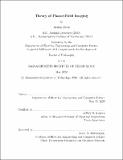Theory of phasor-field imaging
Author(s)
Dove, Justin(Justin Michael)
Download1191624426-MIT.pdf (3.249Mb)
Other Contributors
Massachusetts Institute of Technology. Department of Electrical Engineering and Computer Science.
Advisor
Jeffrey H. Shapiro.
Terms of use
Metadata
Show full item recordAbstract
Phasor-field (P-field) imaging is a promising recent solution to the task of non-line-of-sight (NLoS) imaging, colloquially referred to as "seeing around corners". It consists of treating the oscillating envelope of amplitude-modulated, spatially-incoherent light as if it were itself an optical wave, akin to the oscillations of the underlying electro- magnetic field. We present a formal analysis of P-field propagation using paraxial wave optics and demonstrate how it can be used to form images of hidden diffuse targets both computationally and with physical lenses. In both cases, we find that hidden target planes can be imaged at the modulation-wavelength diffraction limit, despite the presence of intervening diffusers. To model propagation through more general scenarios, we introduce the two-frequency spatial Wigner distribution and derive primitives that characterize its behavior. These primitives are used to analyze occlusion-aided imaging scenarios as well as to verify intuitive results in the geometric-optics limit. Consistent with prior work, we find that intervening occluders offer the potential to form convolutional images of hidden target planes, even in the absence of time-of-flight information. Additionally, we demonstrate how to extend our frame-work beyond the paraxial regime and include a thorough exploration of the effects of speckle, which we find are likely manageable in realistic scenarios.
Description
Thesis: Ph. D., Massachusetts Institute of Technology, Department of Electrical Engineering and Computer Science, May, 2020 Cataloged from the official PDF of thesis. Includes bibliographical references (pages 141-143).
Date issued
2020Department
Massachusetts Institute of Technology. Department of Electrical Engineering and Computer SciencePublisher
Massachusetts Institute of Technology
Keywords
Electrical Engineering and Computer Science.